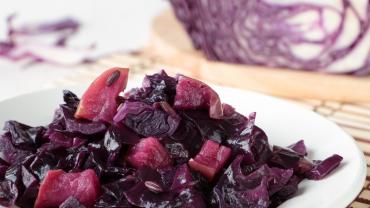
When we look at brightly colored vegetables and fruits sometimes the bold pigments just scream nutrition. Whether it’s the lycopene in tomatoes watermelon and guava the carotenoids in orange-fleshed winter squash or the anthocyanins in red and purple foods such as raspberries cranberries and eggplant the eye-catching colors tend to clue us in that beneficial phytochemicals are present. (But lest we stereotype let’s remember even white foods—such as cauliflower and garlic—pack a nutritional punch.) With regard to that last category—red/purple foods—beyond berries red onions and red wine let’s not neglect red cabbage.
Nutrient-wise red cabbage is a good source of vitamins C and K and contains significant amounts of vitamin A precursors. It provides manganese potassium and small amounts of other minerals. It’s high in fiber and very low in calories yet it’s fairly filling making it a good choice for those who find that losing weight or maintaining a healthy weight is easier if they feel satiated by eating larger amounts of foods that are low in calories.
Like other non-starchy vegetables red cabbage fits easily into many different eating plans. It’s right at home in diets as diverse as Paleo low carb low fat ketogenic vegan and vegetarian. And it’s versatile too: it can be eaten raw cooked fermented or for those who avoid wraps or tortillas made from wheat or corn flour it can be used to wrap other foods. Red cabbage makes a crunchy coleslaw or can be braised with apples and vinegar for a hearty winter side dish.
There may be reasons to enjoy cabbage in a variety of preparations. Bioavailbility of cabbage’s anthocyanins differs depending on the food matrix and preparation methods. According to one study compared to fresh cabbage the anthocyanin content of fermented red cabbage and cabbage that was stewed for either 30 or 60 minutes decreased by 24% 25% and 34% respectively. Anthocyanin content may also be subject to degradation during storage with the effect increasing with the length of time of storage. Regarding antioxidant capacity fresh red cabbage had stronger antioxidant capacity compared to fermented stored and stewed. None of the processes completely eliminated the beneficial compounds nor rendered the antioxidant capacity null so while raw cabbage might have the highest amounts and bioavailability of these phytochemicals the best way to eat cabbage is the way you prefer it be that pickled fermented raw or cooked.
In a small study that assessed the bioavailability of red cabbage anthocyanins from fresh or fermented samples bioavailability from fresh cabbage was more than 10% higher than from fermented. Subjects’ plasma showed higher antioxidant capacity after consumption of fresh cabbage than after fermented. So the bioavailability of these polyphenols from red cabbage is reduced when the cabbage is fermented but the main benefit of consuming fermented vegetables is the probiotics they provide so a lower amount of phytochemicals shouldn’t be a deal-breaker.
Now that we’ve explored some reasons why to include red cabbage in the diet what about how? There are endless ways! Go for a bit of savory and umami with red cabbage sautéed with onions garlic and anchovy or make a big batch of comfort food in the form of braised red cabbage. Planning a Paleo picnic? Be the hit of the party with this delicious vinegar-based coleslaw. (Prefer a creamy version using mayonnaise? Try this one.) For an even more unique twist how about one where cranberries apples and pecans accompany red cabbage? (Perfect for your next Thanksgiving spread!) And how could we forget the cabbage classic sauerkraut? Though not as common as with green cabbage there’s no reason to eschew the red variety when making a batch of homemade ‘kraut. And for those who avoid grain get creative and use cabbage leaves as taco shells!